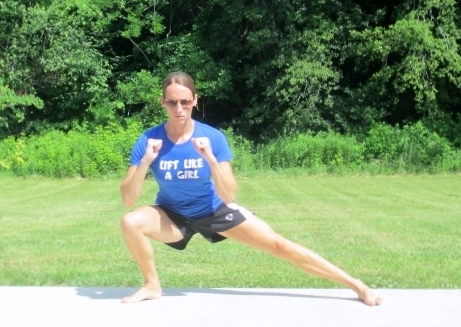 There are so many great exercises that some of them, unfortunately, can go unnoticed or get left behind.
There are so many great exercises that some of them, unfortunately, can go unnoticed or get left behind.
Today you’re going to see one of my personal favorite, underutilized, single leg exercises.
The lateral lunge.
You’ll also see the many benefits this exercise has to offer, reasons to include it in your program, and several progressions from beginner to advanced variations.
First, let’s kick this off with the demonstration video and then I’ll provide some additional coaching cues and information for proper performance.
The lateral lunge is a terrific exercise because it allows you to work in a different plane of motion than you typically work in most exercises. The majority of exercises we perform involve moving backward and forward, in some form or another via the sagittal plane. Just think about a reverse lunge, rear foot elevated split squat, step up, and even the good ole fashion barbell back squat; all of these exercises take place in the sagittal plane.
The lateral lunge, however, introduces a different plane of movement where you work laterally, or what’s known as working in the frontal plane of movement. I’ve found this exercise useful in managing some SI joint pain I’ve experienced, and while I don’t have any scientific research to prove that this is what has helped me, Dave Dellanave wrote a terrific article about how to manage SI joint pain while lifting. And in that article he says, “If you suffer from SI joint pain, chances are you’ve been locked into the same ranges of motion for too long.”
Even if you don’t have SI joint pain, it’s still a great idea to work various planes of movement for overall health, mobility, and strength. And the lateral lunge is a terrific movement to incorporate into your workout program.
Heck, it could even be used during your pre-workout warm-up, if you prefer.
As explained in the video, the lateral lunge performed with a near full range of motion is a fairly advanced exercise (and that’s why it’s used in the Advanced 16 Week Train to be Awesome Program). That’s also why I recommend most people begin with the assisted variations, as shown in the video.
Begin by going down as far as comfortable and gradually increase the range of motion. When you’re comfortable performing the assisted version with a near full range of motion (your butt doesn’t have to touch your calves; hitting parallel or a bit lower is sufficient), progress to doing them without any assistance.
And finally, once you can perform at least 15 reps per leg with the traditional lateral lunge, you can start adding resistance with dumbbells, a weight vest, or even a barbell.
Now that you know why the lateral lunge is such a great exercise and the benefits it provides, here are the coaching cues to ensure correct performance.
Coaching Cues for the Lateral Lunge
- No matter what variation you perform, from the beginner progression to the advanced version, I recommend maintaining a slight forward lean with the torso; it’s more natural and puts you in a better position to hit the glutes.
- Take a wide step to either side, land softly, and lower under control. The non-working leg should be straight.
- Descend down as far as you comfortably can; you can progress to going lower, gradually, over the course of a few workouts.
- I like to point the toes of my working leg out to the side slightly instead of my foot facing completely forward (you can see this in the video); this just feels more natural. Think of how you position your feet during a squat – the slight angle out to the side is how I position my feet with the lateral lunge.
- Make sure the foot of the working leg remains flat on the ground; don’t raise up on your heel or toes.
- Drive back to the starting position by driving through the foot of the working leg. I like to focus on pushing through the heel and balls of my feet.
- You can either perform them alternating (left leg, right leg, left leg, etc) or do all of the reps on one leg before doing them on the other.
Whether you work out exclusively with bodyweight exercises or you’re looking for a new exercise to include in your program or pre-workout warm-up, give the lateral lunge a try for several weeks.
And as I warned in the video, if you’re performing lateral lunges for the first time, you can expect some soreness in your glutes and inner thighs the next day.
Don’t forget to sign up to receive updates for new articles posted to Lift Like a Girl. You’ll also receive insider-only information AND a free gift (spoiler alert: the Beautiful Badass Mini Course), just because you’re awesome. Sign up below.